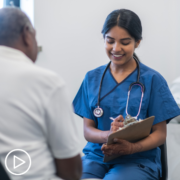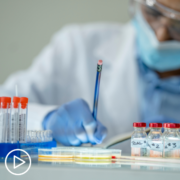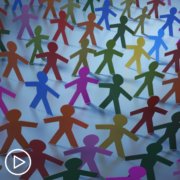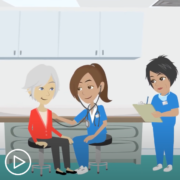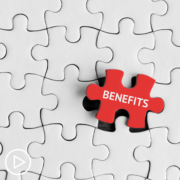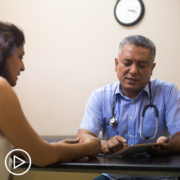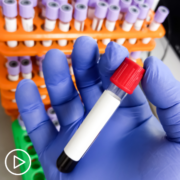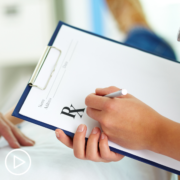What Patient Types Are Good Candidates for CAR T-Cell Therapy? from Patient Empowerment Network on Vimeo.
For CAR T-cell therapy, what patient types are good candidates? Expert Dr. Krina Patel from The University of Texas MD Anderson Cancer Center discusses patient situations that qualify them for CAR T-cell therapy and shares proactive patient advice.
[ACT]IVATION TIP
“I think a lot of people have this misunderstanding that CAR T isn’t for everybody, but I will say it’s actually more likely that you’re going to be eligible for CAR T over auto transplant. So I think it’s just bringing it up, talking to them, and seeing a specialist to discuss which ones are the right one for you and when to go.”
Download Guide | Descargar Guía
See More from [ACT]IVATED CAR T
Related Resources:
Transcript:
Lisa Hatfield:
Dr. Patel, given that CAR T is approved for earlier lines of therapy, can you describe the type of disease characteristics of patients that are likely to be considered first for CAR T?
Dr. Krina Patel:
Yeah, I think it’s a really exciting time, we got approval for two different CAR Ts that were approved in fifth line. So patients had to relapse four times before they could get to CAR T therapy. And now one of them, cilta-cel ciltacabtagene autoleucel [Carvykti], is approved in second line, so people have to relapse once before they can get it.
And the other CAR T, ide-cel (idecabtagene vicleucel) [Abecma], is approved in third line, so you have to relapse twice. There are reasons why that is the way it is, but both of these CAR Ts are pretty fantastic, and we’re really excited that more patients will now have access. As you can imagine, relapsing once, it’s already hard enough to then say, okay, I need a different therapy, but to go through four times before you can do something like CAR T is really, really important.
So I think the biggest characteristic, and I would say for my patients, it’s really their ability to keep their myeloma controlled for at least six to eight weeks, potentially, right? Because this is a personalized therapy, unlike most other myeloma therapies where we have to take the T cells out, we have to then send them to a lab to make the CARs, then it takes about four to six weeks to get them back. During that time, I just have to know that your myeloma can stay controlled or even improve with whatever bridging therapy we decide to do during that time.
And we know that when patients have myeloma that is on its way down, that it’s actually improving, by the time they get to the CAR T therapy, the infusion part, they tend to do better in terms of efficacy, but also have less toxicity. So there’s a few different toxicities that we can talk about with CAR T that are very distinct compared to most other therapies, that again, if you have less disease burden, the rates of that toxicity and the high-grade toxicity goes away, right? It’s much, much lower than if you have a lot of myeloma coming in.
So, again, for my patients who have disease that I know I have other therapies to keep it knocked down or to knock it down during that bridging, that really is the main difference between, can I take this patient to CAR T or not? But I think there’s some nuances too, again, that idea that one CAR T is approved in second line, another one is approved in third line, I do think they’ve never been tested head to head, so we don’t have data in a clinical trial, but in the real world, we’ve used both of these products, a lot of us have, and I think most of us will say that one of the products is probably stronger, it probably works better cilta-cel, and that is the one that’s approved in second line, which is great.
So for my fit patients who don’t have a lot of comorbidities, who do really have high-risk disease that I need to be as aggressive as possible and do something very different, hands down, it makes sense that cilta-cel is the right thing to do right at second line, but the toxicity is also a little bit higher with that, meaning that patients are more likely to potentially get some of these strange neurotoxicities that we see, that we didn’t really see before with other therapies, some of our myeloma patients get neuropathy and we think about that as neurotoxicity, but this is different.
This is more patients after 30 days of having had their T cells can all of a sudden get a facial palsy where they’re having drooping of their face and it can affect their eating and their speaking. Now those things are not fatal, we can treat it with steroids, things like that, but they can affect your quality of life. And if it doesn’t resolve, that can affect down the road, all the other therapies we want to give you, right? But the more dangerous one is something called delayed Parkinsonianism or delayed motor neurotoxicities.
And again, we know the best prevention of that is decreasing the myeloma burden before going to CAR T, but if we can’t do that or some patients can still potentially get this Parkinsonianism, we really want to make sure there’s a risk-benefit discussion, right? That we say, okay, this is why we should go in second line.
Again, the risk is less than 1 percent now based on how we’ve done things for prevention. But on the other hand, with ide-cel, most of our patients, even on dialysis, our patients that are getting CAR T and doing well, patients with heart failure, I’ve had a 90-year-old go through ide-cel without any issues and have great responses. So I think both of these offer, one of the first times they offer time without any therapy for myeloma. And so I would say this is something most of my patients should ask their physicians about, but really then it’s nuanced in terms of when we should do it and which product.
Lisa Hatfield:
Okay, thank you. And do you have an activation tip for that question, Dr. Patel?
Dr. Krina Patel:
Yeah, so I think the activation tip here is bring it up, bring up CAR T to your doctors, right? I think a lot of people have this misunderstanding that CAR T isn’t for everybody, but I will say it’s actually more likely that you’re going to be eligible for CAR T over auto transplant. So I think it’s just bringing it up, talking to them, and seeing a specialist to discuss which ones are the right one for you and when to go.
Share Your Feedback
Create your own user feedback survey

